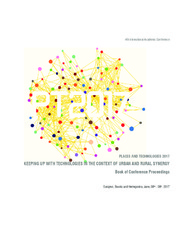Приказ основних података о документу
Food tourism concept - creating synergy between urban and rural places - case study of Maglič, Serbia
| dc.creator | Mitrović, Biserka | |
| dc.creator | Marić, Jelena | |
| dc.creator | Radić, Tamara | |
| dc.date.accessioned | 2020-04-14T09:07:42Z | |
| dc.date.available | 2020-04-14T09:07:42Z | |
| dc.date.issued | 2017 | |
| dc.identifier.isbn | 978-9958-691-56-0 | |
| dc.identifier.uri | https://raf.arh.bg.ac.rs/handle/123456789/578 | |
| dc.description.abstract | Food tourism is being seen as one of the fastest growing industries over the second half of the twentieth century (e.g. Saeter, 1998; Smith, 1988) and a key support for the rural development. In declining rural areas, food tourism is often seen as an additional economic activity and a method of retaining rural regions (Font and Ahjem, 1999). Urban-rural connections are important for poverty assuagement, sustainable rural land use and balanced territorial development in general. Additionally, strong bonds can improve the overall living conditions and employment chances for both rural and urban areas (Tacoli, 1998, 2003; Rosenthal, 2000). The primary purpose of this study is to foster relationships between urban and rural areas by developing a concept proposal for food tourism, through the........ at the Faculty of Architecture, University of Belgrade. The proposal was created during the two theoretical and project-based courses, focused on the sustainable planning and design in the natural environment. The location chosen for the project is a medieval fortress ..... with its surroundings, located in the gorge of Ibar, 20 km south of the city of Kraljevo. Having lost its primary function, the site is nowadays poorly visited. This problem is seen as a challenge to reinvent the urban/rural landscape and create an attractive ambient which relates to the revitalised historical site. As a result, the specific concept of food tourism called “slow food” is developed, both based on tradition and modern values, further elaborated through the planning proposal and urban design project. Following the specific planning and urban design methodology, the extensive research is drawn upon mostly primary and secondary sources, including analysis of urban plans in different scales, comprehensive literature review, as well as cooperation with local authorities and institutions. The full purpose and value of the proposal are confirmed by the city government of Kraljevo and several city agencies and institutes, as the proposal initialized the discussion and revival of the ideas for the important but forgotten historic place and its rural background. | en |
| dc.language.iso | en | sr |
| dc.publisher | Sarajevo : Arhitektonski fakultet | sr |
| dc.rights | openAccess | sr |
| dc.source | Keeping up with technologies in the context of urban and rural synergy [Elektronski izvor] : book of conference proceedings / [4th International academic conference] Places and technologies 2017, Sarajevo, June, 08th - 09th, 2017 | sr |
| dc.subject | Urban and rural places | sr |
| dc.subject | Food | sr |
| dc.subject | Tourism | sr |
| dc.subject | Education | sr |
| dc.subject | Maglič | sr |
| dc.title | Food tourism concept - creating synergy between urban and rural places - case study of Maglič, Serbia | en |
| dc.type | conferenceObject | sr |
| dc.rights.license | ARR | sr |
| dcterms.abstract | Радић, Тамара; Митровић, Бисерка; Марић, Јелена; | |
| dc.citation.spage | 593 | |
| dc.citation.epage | 606 | |
| dc.identifier.fulltext | https://raf.arh.bg.ac.rs/bitstream/id/1519/Book_of_Proceedings_PT2017SarajevoBMitrovicJMaricRadic.pdf | |
| dc.identifier.rcub | https://hdl.handle.net/21.15107/rcub_raf_578 | |
| dc.type.version | publishedVersion | sr |

